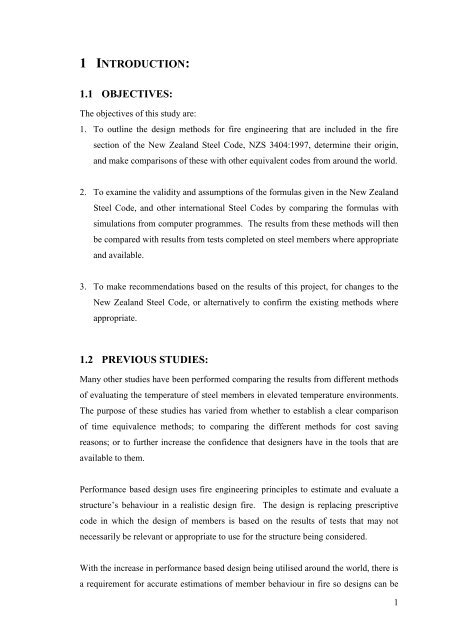FIRE DESIGN OF STEEL MEMBERS - Civil and Natural Resources ...
FIRE DESIGN OF STEEL MEMBERS - Civil and Natural Resources ...
FIRE DESIGN OF STEEL MEMBERS - Civil and Natural Resources ...
You also want an ePaper? Increase the reach of your titles
YUMPU automatically turns print PDFs into web optimized ePapers that Google loves.
1 INTRODUCTION:<br />
1.1 OBJECTIVES:<br />
The objectives of this study are:<br />
1. To outline the design methods for fire engineering that are included in the fire<br />
section of the New Zeal<strong>and</strong> Steel Code, NZS 3404:1997, determine their origin,<br />
<strong>and</strong> make comparisons of these with other equivalent codes from around the world.<br />
2. To examine the validity <strong>and</strong> assumptions of the formulas given in the New Zeal<strong>and</strong><br />
Steel Code, <strong>and</strong> other international Steel Codes by comparing the formulas with<br />
simulations from computer programmes. The results from these methods will then<br />
be compared with results from tests completed on steel members where appropriate<br />
<strong>and</strong> available.<br />
3. To make recommendations based on the results of this project, for changes to the<br />
New Zeal<strong>and</strong> Steel Code, or alternatively to confirm the existing methods where<br />
appropriate.<br />
1.2 PREVIOUS STUDIES:<br />
Many other studies have been performed comparing the results from different methods<br />
of evaluating the temperature of steel members in elevated temperature environments.<br />
The purpose of these studies has varied from whether to establish a clear comparison<br />
of time equivalence methods; to comparing the different methods for cost saving<br />
reasons; or to further increase the confidence that designers have in the tools that are<br />
available to them.<br />
Performance based design uses fire engineering principles to estimate <strong>and</strong> evaluate a<br />
structure’s behaviour in a realistic design fire. The design is replacing prescriptive<br />
code in which the design of members is based on the results of tests that may not<br />
necessarily be relevant or appropriate to use for the structure being considered.<br />
With the increase in performance based design being utilised around the world, there is<br />
a requirement for accurate estimations of member behaviour in fire so designs can be<br />
1
















